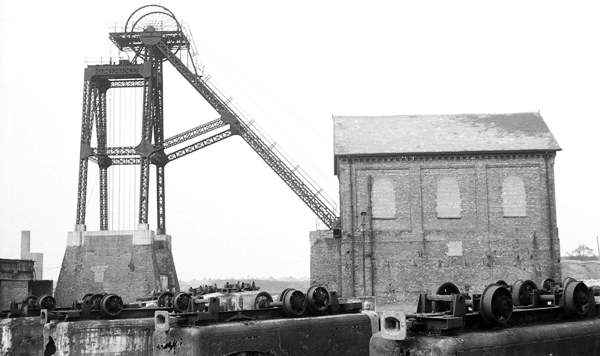
Ashton Moss Colliery
Used with kind permission of Heritage Photo Archive
In March 1875 the Ashton Moss Colliery Co. began sinking shafts alongside the L&NWR’s Guide Bridge Junction Railway at Audenshaw. In order to get through the 45 metres or so of drift, the shaft was sunk 7.3 metres diameter and lined with nine inch brickwork down to the rock head. An inner lining, giving a finished diameter of 5.3 metres, was then built and the intervening space filled with concrete. The shaft was lined with nine inch brickwork, giving an internal diameter of 4.9 metres, through the rock. Water was caught in cast iron rings, called garlands, and piped down to the nearest pumping lodge in the shaft.
When completed in 1881 the shafts at Ashton Moss were the deepest in the country, working the Six Foot Mine at 846 metres and the Four Foot (Black) Mine at 878 metres deep. This was beyond the limits then believed possible. Coal winding began in May 1882.
Ventilation was provided by a furnace half way down the pit, supplemented by a boiler fire at the bottom. The winding engine, by Messrs Garforth of Dunkinfield, had two horizontal cylinders (0.9 m. and 1.5 m. diameter) driving a conical winding drum. It lifted two three-decked cages which each held six 10.5 cwt tubs of coal.
Having proved the colliery, the Ashton Moss Colliery Co. took limited liability in 1887, but it must have struggled because the New Moss Colliery Ltd took over in 1895. Ordnance Survey maps in that period use the name New Moss Colliery. As well as the Great and Roger Mines, this company worked the King, Mary and Town Lane Mines.
Another reorganisation came in 1922, when the Ashton Moss Colliery Ltd took over, and the colliery returned to its original name. The ownership had changed again by 1930, when the Chamber Colliery Co. Ltd, of Oldham, was working Ashton Moss and linked its workings with those of the Oak and Woodpark pits. It worked the Great and Roger mines.
| 1890-1892 | Six Foot |
| 1890-1892 | Four Foot (Black) |
| 1892 | Furnace Hill |
| 1895-1925 & 1935-1950 | Great |
| 1895-1960 | Roger |
| 1910 | Colonel Hard |
| 1910-1915 | Mary Furnace |
| 1915-1920 | Town Lane |
| 1930 | Furnace |
| 1947-1960 | Colonel |
Under the National Coal Board work in the Great Mine ended in 1950 and work concentrated on the Roger and Colonel Mines. It was merged with Bradford in September 1959, but the shafts continued to be used for man-riding etc. until around 1964. The colliery site was then cleared and is now a retail park.
Sources:
- NMRS Records, Gazetteer of British Collieries
- National Archives: BT31/3951/25050 (1887) Ashton Moss Colliery Co. Ltd
- National Archives: BT31/31791/43879 (1895) New Moss Colliery Ltd
- National Archives: BT31/27269/182368 (1922) Ashton Moss Colliery Ltd

